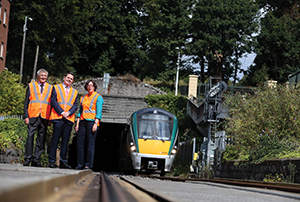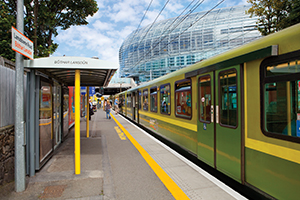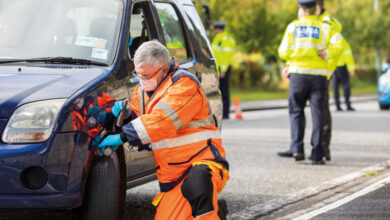Boosting the economy
Iarnród Éireann is ready to play its part in ensuring Ireland has an effective public transport system.
 Think of the great liveable cities of the world. Vienna, Vancouver, Melbourne, Zurich and others regularly found at the top of global rankings.
Think of the great liveable cities of the world. Vienna, Vancouver, Melbourne, Zurich and others regularly found at the top of global rankings.
In survey after survey, mobility in these cities is dominated by effective public transport systems. At the heart of these systems is a high-capacity rail network, and planning and development which supports sustainable travel and living.
As our delicate economic revival continues, the most immediate pressures are being felt once again in our urban centres, with congestion returning, traffic volumes reaching boom-era levels and the unsustainability of car-dominated commuting clearer than ever.
This is most acute in the Greater Dublin Area, where conservative forecasts show a 35 per cent increase in morning peak travel demand by 2041 or 650,000 additional trips to and from work per day.
Clearly this increase in transport demand needs to be supported by sustainable public transport options, with Dublin recently identified as being the 10th most congested large city in the world with an average route taking 35 per cent longer than it would in free-flowing traffic.
As home to 39 per cent of the population and 43 per cent of jobs, the economic wellbeing of the greater Dublin area is central to national economic recovery. It accounts for almost half of national GDP and its effective management and continued success is critical for the performance of the entire economy.
Furthermore, the new COP 21 UN Climate Change agreement puts an onus on Ireland as a country to work to reduce transport emissions significantly, which currently account for 30 per cent of Ireland’s emissions, second only to agriculture.
So our challenges are clear. Thankfully, so are the solutions.
Investing for our future
Iarnród Éireann is planning to address the forecast demand and expand the scope and capacity of our rail network to ensure we provide the high-capacity public transport solutions needed for a sustainable future.
Through a mix of shorter-term and longer-term projects, we can keep pace with the emerging pressures from a growing population, and help support the type of planning essential to achieve sustainability.
In 2016, two projects will be delivered which will allow more commuters to travel by rail:
• In April, we will increase the frequency of DART services from every 15 minutes to every 10 minutes in each direction all day on weekdays, as well as providing additional weekend frequency. DART passenger numbers grew by 8 per cent in 2015 over the previous twelve months, and the enhanced capacity provided by a more frequent service will allow for further projected growth;
• Towards the end of 2016, the Phoenix Park Tunnel line will be open to commuter trains daily, offering direct Kildare to Connolly/Grand Canal Dock services for the first time. This €13.7 million project, funded by the Department of Transport, Tourism and Sport through the National Transport Authority – together with ongoing signalling works – will offer new connections to commuters. There will be a higher frequency of services for customers on the Kildare commuter line, who will have a choice of Heuston and Connolly/Grand Canal Dock services operating. It is forecast that up to one million additional journeys annually will be made by public transport as a result.
The key to our future network
However, while the options commuters have are set to expand imminently, there remains a missing link constraining the rail transport options available to the Greater Dublin area.
The DART Underground line is at the heart of the DART Expansion Programme, a series of projects which would develop and expand the DART network in the Greater Dublin Area, building on one of Ireland’s great public transport success stories, the DART.
The programme includes:
• the DART Underground line, a high-capacity second DART line running underground through the heart of Dublin city;
• electrification of the northern commuter line from the existing end of the DART network in Malahide on to Drogheda;
• electrification of the line from Heuston to Hazelhatch and completion of the four-tracking of this line between Inchicore and Park West;
• electrification of the line from Connolly to Maynooth, together with removal of level crossings and resignalling;
• expansion of fleet and depot facilities.
 This will result in a high-capacity integrated rail network across the Greater Dublin area which will meet the transport needs of our communities and our economy, and prevent chronic congestion which would damage both.
This will result in a high-capacity integrated rail network across the Greater Dublin area which will meet the transport needs of our communities and our economy, and prevent chronic congestion which would damage both.
It has the potential to treble the capacity of the rail network passing through the heart of Dublin, and connect all rail modes – DART, Commuter, Intercity, Luas and forthcoming Metro – together to from a truly integrated network.
The project is currently being reviewed by Iarnród Éireann and the National Transport Authority to provide a lower-cost technical solution whilst retaining the essential rail connectivity. Design and planning is being advanced to ensure construction can commence after 2020, as pressure on our urban transport capacity accelerates.
Airport Rail Link
While not included in the recently announced capital programme, Iarnród Éireann has also proposed a DART Airport link that would see a spur off the DART line at Clongriffin to the airport, allowing direct high-capacity DARTs to operate from the airport to Dublin Connolly and Pearse Stations and the entire DART network at least every 15 minutes.
It supports the European Union’s policy goal of ensuring major airports are linked to the national rail network, and would also align in future into the expanded network delivered by DART Expansion. This would allow airport DARTs to operate directly to the Docklands/IFSC area; Pearse; St Stephen’s Green; Christchurch and Heuston Stations in such a network, serving key business, commercial and tourism areas. For this low cost option, the alignment for the airport rail link from the airport to Clongriffin is directly underneath the main flightpath to the airport and is undeveloped, meaning construction could take place without disruption to residential or commercial interests, or to the city’s existing infrastructure. It is imperative that this alignment is protected to ensure this strategic option remains available as our city develops.
Demand Management Measures
Iarnród Éireann has also welcomed the strong emphasis on wide ranging demand management measures contained in the draft Dublin City Council/ National Transport Authority Greater Dublin Area strategy.
In particular, it is essential that there is ongoing implementation of land-use policies which support the provision of new developments in locations and at densities which enable the efficient provision of public transport services.
We stand at a point of opportunity again for shaping the future of our transport services. Rail transport is ready to play its part in ensuring our economy, our planning and our future sustainability gains maximum benefit.
For more information on Iarnród Éireann visit www.irishrail.ie





